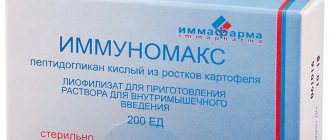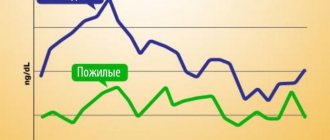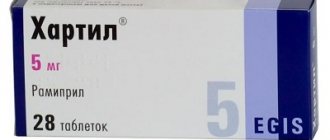Release form and composition
The dosage form of Tebantin is Coni-Snap capsules: hard gelatin, pinkish-brown cap, body color depends on the dose of the drug; capsules are filled with white or almost white crystalline powder (10 pieces in blisters, 5 or 10 blisters in a cardboard box):
- dose 100 mg: capsule size No. 3, white body;
- dose 300 mg: capsule size No. 1, light yellow body;
- dose 400 mg: capsule size No. 0, yellowish-orange body.
1 capsule contains:
- active ingredient: gabapentin – 100, 300 or 400 mg;
- auxiliary components: talc, lactose monohydrate, magnesium stearate, pregelatinized starch;
- capsule cap: red iron oxide dye (E172), yellow iron oxide dye (E172), titanium dioxide (E171), gelatin;
- capsule body: red iron oxide dye (E172) and yellow iron oxide dye (E172) - for a dose of 300 and 400 mg, titanium dioxide (E171), gelatin.
Pharmacological properties
Pharmacodynamics
Gabapentin is a lipophilic substance whose structure is similar to the structure of the neurotransmitter gamma-aminobutyric acid (GABA). At the same time, the mechanism of action of gabapentin differs from some other drugs that interact with GABA receptors: it does not exhibit GABAergic properties and does not affect the uptake and metabolism of GABA.
Preliminary studies suggest that gabapentin binds to the α2-δ subunit of voltage-gated calcium channels and inhibits the flow of calcium ions, which plays an important role in neuropathic pain. The effect of gabapentin in neuropathic pain is also due to the following mechanisms:
- increased GABA synthesis;
- reduction of glutamate-dependent neuronal death;
- suppression of the release of monoamine neurotransmitters.
At clinically significant concentrations, gabapentin is not able to bind to the receptors of other common drugs or transmitters (including GABAA and GABAB, N-methyl-D-aspartate, glycine, glutamate or benzodiazepine receptors). Unlike carbamazepine and phenytoin, this substance is not capable of interacting with sodium channels in vitro.
Data from some in vitro tests suggest that gabapentin may partially attenuate the effects of the glutamate receptor agonist N-methyl-D-aspartate, but this pattern is only true at concentrations greater than 100 µM, which cannot be achieved in vivo.
Gabapentin is able to slightly reduce the release of monoamine neurotransmitters and modify the activity of the enzymes glutamate synthetase and GABA synthetase in vitro. Experiments on rats indicate an increase in GABA metabolism in some areas of the brain, but the significance of these effects for the anticonvulsant activity of gabapentin has not been established. In animals, this substance can easily penetrate brain tissue and prevent seizures that are caused by genetic factors or caused by chemicals (including GABA synthesis inhibitors) or maximum electric shock.
Pharmacokinetics
The drug is rapidly absorbed, and maximum plasma concentration is observed after 3 hours. After repeated administration, to achieve maximum concentration it takes 1 hour less than with a single dose. The absolute bioavailability of gabapentin in capsules is approximately 60%. As the dose of the drug increases, the bioavailability of this substance decreases.
Simultaneous administration of Tebantin with food, including food containing a large amount of fat, increases the Cmax and AUC of gabapentin by approximately 14% and at the same time does not significantly affect the pharmacokinetics of the substance.
When taking 300–4800 mg of gabapentin, the average AUC and Cmax values increase with increasing dose. At doses of no more than 600 mg, the deviation from linearity of both indicators is small, and at higher doses the increase is not so significant.
With a single oral dose, the concentration of the drug in plasma in children 4–12 years of age is similar to that in adult patients. The equilibrium state with repeated doses was achieved after 1-2 days and remained throughout the entire course of therapy.
Gabapentin is practically not metabolized in the human body. In addition, this substance does not have the ability to induce oxidative liver enzymes with mixed function, which are involved in the metabolism of drugs.
Gabapentin is practically incapable of binding to plasma proteins (less than 3%), and its volume of distribution is 57.7 liters. The concentration of gabapentin in the cerebrospinal fluid is 20% of the concentration in plasma at steady state. This substance can cross the blood-brain barrier and enter breast milk.
The elimination of Tebantine from plasma has a linear relationship. The half-life is independent of dose and ranges from 5 to 7 hours. Plasma clearance, renal clearance and elimination rate constant of gabapentin are directly proportional to creatinine clearance. Gabapentin is excreted unchanged through the kidneys and is also removed from the plasma during hemodialysis.
In elderly patients and patients with impaired renal function, plasma clearance of gabapentin is reduced. With creatinine clearance less than 30 ml/min, the half-life is approximately 52 hours. When treating patients with impaired renal function and those on hemodialysis, dose adjustment is recommended.
Interaction
The drug is regularly administered by neurologists as part of various complex therapy options. Time-tested treatment regimens are safe and effective. With some products, the antiepileptic composition may cause undesirable reactions. For this reason, it is important to always coordinate the use of any medications simultaneously with Tebantin.
Medications in combination with Tebantin can provoke the following consequences:
- the effect of oral contraceptives with ethinyl estradiol and/or norethisterone does not change with monotherapy. Against the background of complex use of antiepileptic drugs, the effectiveness of contraceptives decreases;
- Antacids reduce the bioavailability of the active substance by almost a quarter. This will not happen if you take a 2-hour break after taking antacids;
- Cimetidine reduces the amount of drug excreted by the kidneys, but in most cases this has no clinical significance;
- formulations with alcohol and agents that affect the functionality of the central nervous system increase neurological side reactions of the product;
- the combination of Morphine with medication helps to increase the pain threshold, but this does not manifest itself clinically.
Concomitant use of Tebantine and other anticonvulsants causes a false-positive urine protein test if the test is carried out using semi-quantitative tests. To establish the truth, it is recommended to use more specific tests.
Contraindications
Absolute:
- inflammation of the pancreas (pancreatitis) in acute form;
- lactation (breastfeeding period);
- children under 3 years of age (all types of therapy);
- children age 3–12 years (monotherapy);
- lactose intolerance, lactase deficiency, glucose-galactose malabsorption;
- hypersensitivity to gabapentin and auxiliary components of the drug.
The drug should be prescribed with caution to patients with impaired renal function.
During pregnancy, Tebantin is used only if the expected benefit to the mother exceeds the possible risk to the fetus.
Instructions for use of Tebantin: method and dosage
Tebantin capsules are taken orally, without chewing, with sufficient liquid. The effectiveness of the drug does not depend on diet. When taking three times, it is important to consider that the break between two doses should not be more than 12 hours.
Partial seizures in children over 12 years of age and adults
For children over 12 years of age and adult patients, the clinically significant desired antiepileptic effect is usually provided by a dose of 900–1200 mg/day, several days after the start of titration.
Recommended daily dose and basic dosage regimen (A):
- Day I: 300 mg – 1 capsule 300 mg once a day or 1 capsule 100 mg 3 times a day;
- Day II: 600 mg – 2 times a day, 1 capsule 300 mg or 3 times a day, 2 capsules 100 mg;
- Day III: 900 mg – 3 times a day, 1 capsule 300 mg or 3 times a day, 3 capsules 100 mg;
- Day IV and beyond: the dose can be increased to 1200 mg, divided in equal doses into 3 doses (for example, 1 capsule 400 mg 3 times a day).
Alternative dosage regimen (B): on the 1st day of therapy, a starting dose of 900 mg of gabapentin per day is taken, divided into 3 doses of 1 capsule of 300 mg; the next day, the dose can be increased to 1200 mg per day and then (depending on the effect obtained) increased per day by 300–400 mg, but not exceeding the maximum daily dose of 2400 mg (with three doses). The effectiveness and safety of using higher doses of the drug have not been sufficiently studied.
Partial seizures in children 3–12 years old weighing more than 17 kg
Tebantine is used in children aged 3 to 12 years weighing > 17 kg as adjunctive therapy because there is insufficient data on the safety and effectiveness of its use as monotherapy in this age group.
The recommended daily dose of the drug is 25–35 mg/kg and is divided into 3 doses.
Scheme for selecting an effective dose using titration: 1st day – 10 mg/kg/day, 2nd day – 20 mg/kg/day, 3rd day – 30 mg/kg/day. If necessary, in the future the daily dose of gabapentin can be increased to 35 mg/kg/day, divided into 3 doses. Long-term clinical studies confirm good tolerability of doses up to 40–50 mg/kg/day.
Initial dosing regimen until therapeutic doses of gabapentin are achieved (recommended daily doses of gabapentin depending on body weight):
- children weighing 17–25 kg (600 mg per day): 1st day – 200 mg 1 time per day, 2nd day – 200 mg 2 times a day, 3rd day – 200 mg 3 times a day;
- children weighing more than 26 kg (900 mg per day): 1st day - 300 mg 1 time per day, 2nd day - 300 mg 2 times a day, 3rd day - 300 mg 3 times a day.
Tebantin maintenance doses (child weight/dose): 17–25 kg – 600 mg/day, 26–36 kg – 900 mg/day, 37–50 kg – 1200 mg/day, 51–72 kg – 1800 mg/day.
Neuropathic pain
When treating neuropathic pain, the optimal therapeutic dose is determined by the attending physician using a titration method based on the patient’s individual response, tolerability of the drug and its effectiveness. The dose can reach up to 3600 mg per day (maximum).
Recommended daily dose and basic dosage regimen (A):
- Day I: 300 mg – 1 capsule 300 mg once a day or 1 capsule 100 mg 3 times a day;
- Day II: 600 mg – 2 times a day, 1 capsule 300 mg or 3 times a day, 2 capsules 100 mg;
- Day III: 900 mg – 3 times a day, 1 capsule of 300 mg or 3 times a day, 3 capsules of 100 mg.
An alternative dosing regimen for the treatment of intense pain (B): on the 1st day, a starting daily dose of 900 mg of gabapentin is taken (divided into 3 doses), then the dose can be increased over 7 days to 1800 mg per day.
In order to achieve the required analgesic effect, in some cases the dose can be increased to a maximum of 3600 mg per day, divided into 3 doses. In ongoing clinical studies, the dose was increased to 1800 mg in the 1st week, and to 2400 and 3600 mg in the 2nd and 3rd weeks, respectively.
In weakened patients, patients with low body weight, or after organ transplantation, the dose of Tebantine is allowed to be increased strictly by 100 mg per day.
In case of renal failure with creatinine clearance (CC) < 80 ml/min, patients on hemodialysis and elderly people (due to age-related decrease in creatinine clearance), the doctor selects the therapeutic dose individually.
Peculiarities
The increased chemical activity of the drug, the abundance of potential side effects and the lack of complete information about the mechanism of action oblige patients to exercise increased caution when conducting courses. The attending physician should warn the patient about all principles and features of therapy.
For children
For children under three years of age, taking the medicine is contraindicated. It is given to children from 3 to 12 years old only as part of complex therapy. An isolated approach can lead to unexpected negative consequences. The composition is not used for the treatment of neuropathic pain in minors.
Newborns
There is no information on the use of the drug in the first year of life in infants. The variety of product analogues allows you to select an adequate replacement that is not accompanied by such risks.
With alcohol
The combination of alcoholic beverages with a drug leads to increased neurological side effects and increases the likelihood of their development. You must abstain from alcohol for the entire period of treatment.
During pregnancy and lactation
The use of the product in the first trimester of pregnancy is strictly prohibited. The lack of reliable information about the effect of the composition on the embryo does not exclude the risk of developmental defects in the child. In the second and third trimesters, the use of medication is resorted to in extreme cases with the permission of a doctor and with constant monitoring of the child’s condition. In this case, minimal dosages are used, and courses are short.
According to recent studies, there is a high probability of the active substance passing into breast milk. It is not known what consequences this poses to the newborn. To avoid unnecessary risks, breastfeeding is stopped during the treatment course.
Side effects
Treatment of partial seizures
- general malaise: back/chest pain, fatigue, flu-like syndrome, fever, asthenia, poor health;
- central nervous system (CNS): drowsiness/insomnia, headache, dizziness, ataxia, depression, emotional lability, increased nervous excitability, tremor, muscle twitching, hyperkinesis, dysarthria, incoordination, hallucinations, movement disorders (choreoathetosis, dyskinesia, dystonia) , impaired thinking, confusion, paresthesia, nystagmus, tics (dose-dependent), hyperkinesia, increased, weakened or absent reflexes, anxiety, restlessness, hostility, amnesia;
- digestive system: nausea/vomiting, dyspepsia, abdominal pain, increased appetite, dry mouth or throat, diarrhea/constipation, dental lesions, hepatitis, jaundice, pancreatitis, increased activity of liver transaminases, flatulence, gingivitis, anorexia;
- cardiovascular system: symptoms of vasodilation, palpitations, as part of complex therapy - increased blood pressure (BP);
- hematopoietic system: thrombocytopenia, leukopenia;
- musculoskeletal system: myalgia, arthralgia, fractures;
- respiratory system: rhinitis, pharyngitis; as part of complex therapy with other antiepileptic drugs – cough, pneumonia;
- sense organs: noise/ringing in the ears, visual impairment (diplopia, amblyopia);
- urinary system: impaired urinary control, acute renal failure; as part of complex therapy with other antiepileptic drugs - urinary tract infections;
- reproductive system: impotence, gynecomastia, enlargement of the mammary glands;
- hypersensitivity reactions: urticaria, skin rash, itching, fever, angioedema, erythema multiforme (including Stevens-Johnson syndrome);
- other reactions: weight gain, purpura, discoloration of tooth enamel, generalized edema, peripheral edema, facial edema, alopecia, acne, fluctuations in blood glucose concentrations in diabetes mellitus.
Hyperkinesia and hostility have been reported when treated with gabapentin as adjunctive therapy in children under 12 years of age.
Treatment of neuropathic pain
- general malaise: asthenia, infections, flu-like syndrome, headache, accidental injuries, pain of various localizations, back pain;
- digestive system: dyspepsia, constipation/diarrhea, dry mouth, nausea/vomiting, flatulence, abdominal pain;
- nervous system: disorientation, gait disturbance, paresthesia, impaired thinking, drowsiness, tremor;
- sense organs: amblyopia;
- respiratory system: shortness of breath, pharyngitis;
- metabolism: weight gain, peripheral edema;
- dermatological reactions: skin rash.
After abrupt withdrawal of Tebantin, the most commonly observed symptoms are: nausea, insomnia, anxiety, pain of various localizations, and hyperhidrosis.
Symptoms of overdose are: double vision, dizziness, speech impairment, diarrhea, drowsiness and lethargy. To treat the condition, symptomatic therapy is recommended; in severe renal failure, hemodialysis may be indicated. No symptoms of life-threatening acute poisoning were observed even after taking 49 g of the drug per day.
Side effects of the drug Tebantin
From the side of the central nervous system: drowsiness, dizziness, feeling of fatigue and impaired coordination of movements (ataxia), nystagmus, visual impairment (diplopia, amblyopia), headache, tremor, dry mouth, dysarthria, amnesia, thinking disorder, depression, anxiety, emotional lability . From the gastrointestinal tract: nausea, vomiting, anorexia. From the cardiovascular system: vasodilation. From the blood system: leukopenia. Metabolism: peripheral edema. From the musculoskeletal system: bone fractures, myalgia. From the respiratory system: cough, pharyngitis, shortness of breath, rhinitis. From the skin: acne, itching, rash. From the genitourinary system: impotence. Others: weight gain, asthenia, paresthesia, insomnia, abdominal and back pain, feeling of heat. During treatment with gabapentin, hemorrhagic pancreatitis and certain types of allergic reactions (Stevens-Johnson syndrome, erythema multiforme) may occur.
special instructions
It is not necessary to measure the concentration of the drug in plasma when selecting the optimal therapeutic dose.
Treatment of absence epilepsy with gabapentin is ineffective.
The use of gabapentin in patients with diabetes mellitus requires monitoring blood glucose levels and, in some cases, dose adjustment of the hypoglycemic drug.
With the appearance of prolonged pain in the abdominal cavity, nausea, and repeated vomiting (the first signs of acute pancreatitis), treatment with Tebantin must be stopped. Early diagnosis of acute pancreatitis requires a thorough examination (clinical and laboratory tests and tests).
Patients with lactose intolerance should take into account its content in 1 capsule of Tebantin, depending on the dose: 100 mg - 22.14 mg of lactose, 300 mg - 66.42 mg of lactose, 400 mg - 88.56 mg of lactose.
Reduce the dose of the drug, stop treatment, or replace gabapentin with an alternative drug gradually, over at least 1 week. If you stop taking it abruptly, status epilepticus may develop.
Taking the drug should be stopped and consult a doctor if dizziness, drowsiness, ataxia, increased fatigue, nausea/vomiting, weight gain occur in adult patients, or hyperkinesia, drowsiness, hostility in children.
The effectiveness and safety of using Tebantin as a drug for additional treatment of epilepsy in children under 3 years of age, as a monotherapy drug in children under 12 years of age, and for the treatment of neuropathic pain in children and adolescents under 18 years of age has not been established.
During the period of treatment, it is necessary to refrain from engaging in potentially hazardous types of work that require speed of psychomotor reactions and increased concentration of attention, including driving vehicles.
Indications for use of the drug Tebantin
Treatment of neuropathic pain in adults. Epilepsy Adults and children over 12 years of age : as monotherapy or as an additional agent in combination therapy for the treatment of partial epileptic seizures, including those occurring with secondary generalization. Children aged 3 to 12 years : as an additional remedy for the treatment of partial seizures, including those occurring with secondary generalization. Currently, there is not enough experience with the use of the drug as an additional agent in combination therapy for the treatment of children under 3 years of age and its use as monotherapy in children under 12 years of age.
Drug interactions
- phenytoin, valproic acid, carbamazepine, phenobarbital (antiepileptic drugs): no interaction with gabapentin was observed;
- oral contraceptives: gabapentin does not affect the effectiveness of oral contraceptives containing norethisterone/ethinyl estradiol and their pharmacokinetics, but deterioration/cessation of their contraceptive effect is possible when using the drug Tebantin as part of complex therapy with other antiepileptic drugs that reduce the effect of oral contraceptives;
- antacids (magnesium- or aluminum-containing agents that neutralize gastric acidity): reduce the bioavailability of gabapentin by 24% (capsules should be taken 2 hours after antacids);
- cimetidine: the excretion of gabapentin by the kidneys is reduced, which may not have clinical significance;
- alcohol, other drugs that affect the central nervous system: may enhance undesirable side effects of gabapentin on the nervous system, such as drowsiness, ataxia;
- probenecid: has no effect on the renal excretion of gabapentin;
- Morphine: When morphine 60 mg controlled-release capsules were taken 2 hours before taking Tebantine, there was a 44% increase in gabapentin AUC compared to gabapentin monotherapy, resulting in an increase in pain threshold (cold pressor test), but the clinical significance of such changes not installed. Gabapentin, administered 2 hours after morphine, does not change the pharmacokinetic characteristics of the latter, and side effects do not differ from those observed with morphine and placebo.
Laboratory results for the determination of protein in the urine: in the case of using the drug Tebantin as part of complex therapy with other anticonvulsants, false-positive results for determining total protein in the urine using semi-quantitative tests were noted; It is recommended to use a more specific method of precipitation with a 20% solution of sulfosalicylic acid or biuret test.
Drug interactions Tebantin
There were no significant changes in the plasma levels of phenytoin, carbamazepine, valproic acid and phenobarbital, which were used as basic antiepileptic drugs in combination with gabapentin. Gabapentin has no effect on the action of norethindrone and/or ethinyl estradiol-containing oral contraceptives, however, when used in combination with other antiepileptic drugs that reduce their effect, cessation of contraceptive action should be expected. Medicines containing acid-neutralizing aluminum or magnesium may reduce the bioavailability of gabapentin by 24%. Tebantin capsules should be taken no earlier than 2 hours after taking antacids. With simultaneous use of gabapentin and cimetidine, the renal elimination of gabapentin is slightly slowed down.
Reviews about Tebantin
Reviews of Tebantin as a drug for combating neuropathic pain indicate its high effectiveness, but the main condition is compliance with the doctor’s recommendations. The most common side effects are drowsiness and slight dizziness.
Reviews from patients who have used the drug to treat epileptic attacks are quite contradictory: some patients report a decrease in the strength and frequency of attacks, others do not observe any changes in their health.
Overdose
The experiments did not reveal a dosage of the drug that could lead to the death of the patient or serious disorders in his body.
Even with a daily intake of 49 g of medication, the clinical picture of acute poisoning is not observed. Exceeding therapeutic doses of the product may be accompanied by dizziness, loose stools, double vision, drowsiness, and speech problems. In rare cases, lethargy develops. There is no antidote for the active substance. First aid consists of symptomatic treatment. Hemodialysis is indicated for persons with severe renal impairment.







